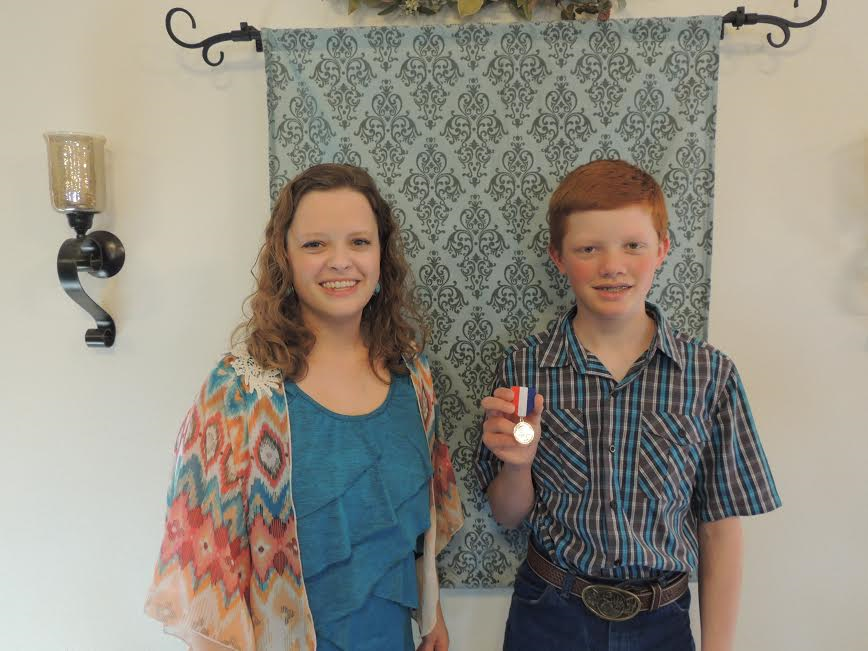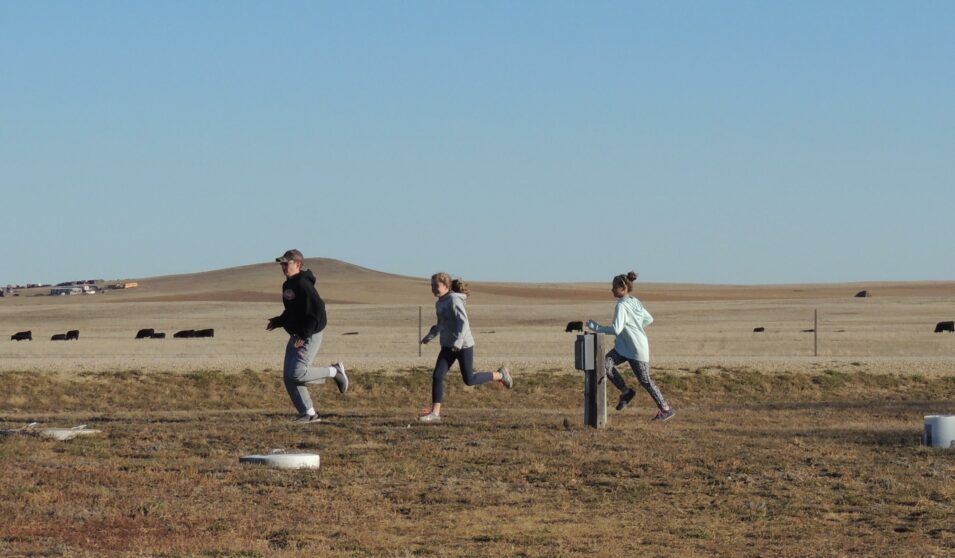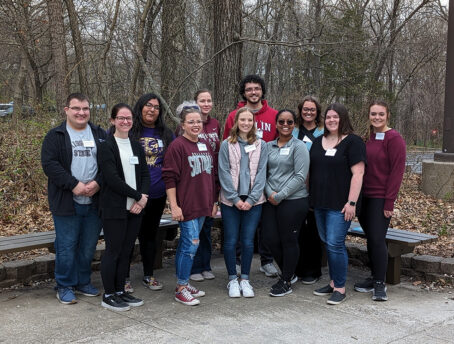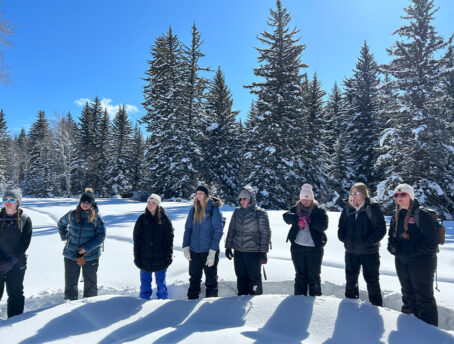Editor's Note: Paul Theobald is a noted rural historian and author, and he is currently a Visiting Professor of Innovation at the University of Southern Indiana. We are pleased that Paul is one of our most committed Advocates. Paul recently interviewed Missy Urbaniak, who teaches at the tiny Altall School in rural Meade County, South Dakota.
This is her story, one that is instructive, fascinating and hopeful.
PRAIRIE PEDAGOGY: BY PAUL THEOBALD
Tell us a little about yourself. How long have you wanted to be a teacher, and when did the possibility of becoming a one-room schoolteacher first come into the picture? How long have you been teaching at this school?
Teaching became my goal at a young age. Teaching at a country school became my passion as I grew older, and by adulthood, teaching at the Atall School had become my dream job. I never attended country school myself; I grew up living just outside of Sturgis, South Dakota and attended Whitewood and Sturgis schools for elementary, middle, and high school. In fourth grade, I had a wonderful teacher who vividly read aloud to us each day, encouraged imaginative thinking, and genuinely cared about each and every student. In my mind, I can still hear her voice reading The Lion, The Witch, & The Wardrobe and Charlie and the Chocolate Factory aloud to us. I began to think that teaching might be the job I wanted someday. My experiences with teachers in fifth and sixth grade solidified those thoughts. But in high school, that goal ultimately evolved into a passion for teaching and working with kids and decided that a country school was where I belonged.
High school is also where I met my husband, Joe. He, too, attended Sturgis schools for kindergarten through twelfth grade. His dream was to run his family’s ranch near Fairpoint, South Dakota and mine was to teach. Luckily for me, the ranch is just five miles from a country school; one that several of my husband’s family members had attended themselves. Before even graduating high school, my ultimate goal became teaching at the Atall School near Joe’s family ranch.
After we married, we lived in Sturgis while I finished earning my teaching degree in Spearfish at Black Hills State University. Upon graduation, the plan was that we would move to the ranch and I would teach at a country school, hopefully the Atall School, but there were three others within driving distance of the ranch. Unfortunately, while I was working on my degree, enrollment in the district dropped and one of my four options closed. The others already had well established teachers, and I was left with no choice but to stay in Sturgis and apply for teaching jobs there. Moving to the ranch without my teaching income simply wasn’t possible, especially since my husband and I now had a baby boy to provide for. My first teaching position was a long-term substitute position for a teacher who had been deployed to Iraq with the National Guard. I ended up completing the entire year as a fifth-grade substitute teacher in Whitewood. After that I taught four years at the Sturgis Williams Middle School; mostly as a fifth-grade reading teacher. All the while, I was waiting for the chance to land a country school teaching job so that we could move to the ranch. By the time that finally happened, our family had grown; we now had three young sons.
In 2008, I finally got the call that there was an opening at the Hereford School. I taught K-8 there for three years, with different grade combinations each year, and had between 7 and 10 students each year. My oldest son was one of four kindergarten students during my first year as a country school teacher. We moved to the ranch in 2009 and I drove 25 miles one way, mostly gravel roads, each day for the next two years, to teach school at Hereford. My oldest son rode with me to attend first and second grade. Then in 2011, the teacher at the Atall School retired. This was it, my dream job! This is now my sixth year of teaching at Atall, and my oldest son is in the eighth grade. I have been his teacher for every grade: kindergarten through eighth. I am getting close to having a decade of experience in the country schools, and I wouldn’t teach anywhere else.
How about your experiences in your teacher preparation program? What parts of the curriculum were directly transferable to the one-room school, and what parts were missing?
My professors at BHSU in the college of education were very progressive; at least at the time, and to my way of thinking! I graduated in December of 2002 with a double major in elementary and special education and a minor in middle school. I had a wonderful college experience. It was truly eye-opening and I would be a completely different person today had I not attended college. I am thankful every day for the time I spent in college, the lessons I learned there, and the people I met.
I was even fortunate enough to be able to student-teach at a country school. I had to submit a special request at the college, and ask the permission of the teacher, principal, and superintendent of the country school, but everyone agreed to give me the opportunity. So, for about nine weeks, I drove from Sturgis to the nearest country school in Meade County at the time, the Alkali School. It has since closed, but I still hold very fond memories of those first days of learning what it really means to be a one-room school teacher!
During my methods training, in the final two years of my college education, my professors’ number one goal was to prepare us for the realities of being a teacher. These professors knew that we were the future of teaching in this state, and did not take lightly their responsibility to train us well. Helping us each shape our own personal philosophy of education, knowing that it would most likely be changed and molded and reshaped and even thrown out countless times, they did not hold back. They spoke to us at length about what they had seen happen nationally in education, what was currently happening, what they predicted would happen, and what they thought it would mean for teachers in South Dakota and neighboring states. Most of what I remember them speaking about has come true. They could see national standards coming, they could see the rise in standardized testing, and the onslaught of charter and voucher school systems. They presented all of this to us, and then asked us, “What do you think? Do you agree with the direction that education is heading?” The magnitude of what happens every single day in each classroom across this nation was not lost on them, and they ensured that is was not lost on us. Sometimes I wondered if they were trying to get us to quit altogether, to choose a different profession. I suppose in a sense, they were! They knew that teaching is not a job for the faint of heart.
Any first-year teacher will most likely tell you that nothing could have prepared them for what teaching really means, for the reality of being put in charge of a classroom. I know that I felt that way. For all of the enormity that is the public education, for the multitude of directions that a teacher can choose to take; in the end one of my professors taught us a mantra that has stuck with me. When faced with all of these questions about education; about what we should teach or shouldn’t teach, how we should teach or shouldn’t teach; it really all should boil down to one question: “Is this what is BEST for KIDS?” “Keep this mantra in mind,” she said, “and you’ll make the right decisions.” So far, it hasn’t steered me wrong. It has forced me to make some tough calls, to let go of practices and ideas that I held dear, but doing what is best for students is ultimately why I am a teacher and I think it pays to keep that in mind. That kind of education applies to any teaching post!
Tell us about your current classroom. How many students? What grades? How do the students get to the school? Is there bussing?
Currently, I teach 3rd-8th grade. My school is technically a two-room schoolhouse. The district hired a first-year teacher for grades K-2nd this year. In all we have fourteen students. There are two teachers, one paraprofessional, and one part-time paraprofessional/special education teacher. My class consists of eight students: three third-graders, one fifth-grader, two sixth-graders (who are twins), one seventh-grader, and one eighth-grader. It was at my request that our school have two teachers this year. Last year I taught seven grade levels, spread out from kindergarten up to eighth grade. Knowing that this year’s enrollment would mean eight grade levels; I simply had to have more help. As it turns out, planning and teaching six subject areas for seven grade levels was my limit. I am pleased to report that this year has gone very well, for both classrooms and for all the students.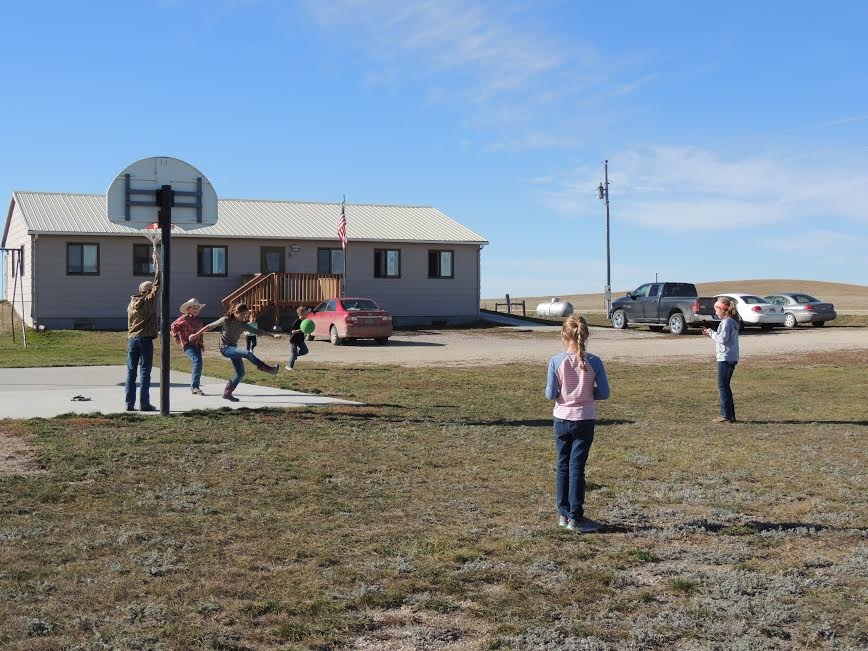
Three of the eight families whose children attend the Atall School belong to the same extended family. We have several students who attend school with their brothers, sisters, and cousins, and whose own parents and grandparents attended school on this very same site. Most of the students live within ten minutes of the school, but there are some who live farther away; twenty-five minutes at the most. The students’ parents usually drop off and pick them up, but some families do a little carpooling. The school is located in a pasture that belongs to one of the families. There are no other buildings around. It is fenced out from the pasture and their house roof is just visible over a little rise in the pasture. The girls sometimes ride their bikes or walk when the weather is nice. Often their father picks them up with a four-wheeler, and sometimes even a tractor for the ride home. It is not uncommon in the spring or fall for the sounds of four-wheelers to drift into our schoolhouse windows. During this time, when the nearby ranchers are moving their herds to fresh pastures, they will trail the cattle right past the school. The students always appreciate a short break to run to the window to see if their dad, mom, uncle, cousin, grandpa, and hired men are the ones trailing cattle that day. All concentration on schoolwork is lost when one of the cattle stray into the schoolyard and the cowboys on horseback have to chase them around the playground equipment!
Our school does not have bussing, but there are two buses for students for the Union Center K-3rd and Enning 4-8th rural schools, the largest of the six rural sites. The Hereford School has a long-standing tradition of saddling up their horses and riding to school on the first day. During the three years that I taught there, my son was fortunate enough to take part in that tradition with his own pony. Decades ago, this was how most students went from home to school and back at the then dozens of rural school sites in Meade County.
How large, geographically, is the district of which your school is a part? How large is it in terms of student numbers? How far away is the high school that your students will one day attend?
The Meade 46-1 School District, to which the Atall School belongs, is the largest district in geographical area in the state of South Dakota. It covers 3,122 square miles and includes the towns of Sturgis, Whitewood, and Summerset/Piedmont as well as several rural communities east of the Belle Fourche River. It is eleventh in the state for enrollment, with roughly 2,700 students K-12. The graduating class of seniors is usually between 150 and 200 students. Whitewood, Sturgis, and Piedmont each have an elementary site. The district’s middle and high schools are both in Sturgis. Currently, there are six rural schools in the district with a total of 108 students in attendance; the highest enrollment we have seen in a decade or more. The students from these attendance centers will attend a variety of high schools, most of them outside of the Meade County. Some will continue in the Meade 46-1 District and attend Sturgis Brown High School, roughly one hour away. But for some in the northern part of Meade County, that drive would be more like two hours, so they will attend Faith High School. Some of my former students, here in the center of the county, attend Newell High School. In the south, some students will attend Wall or New Underwood for high school. Others may go as far as Philip. All these surrounding high schools are small, rural school themselves, that have four-day weeks; except for Sturgis.
No matter which high school rural students attend, the majority of them will have to board away from home at least part-time during their high school years. Often times they stay with a grandparent who has moved to town from the ranch, or another relative. But there are cases in which a few families pool their resources and buy or rent a small house or apartment in town for the students to live in while the parents take turns driving in to supervise.
Historically, “recitations,” were a big part of one-room school pedagogy. Do you use that instructional technique? Can you walk us through a typical school day in terms of where and how you exert your instructional efforts?
In my room, we begin the day with a whole-class poetry study. Then, while a paraprofessional assists the other four grade levels with spelling, I give math lessons at a separate table. The five grade levels rotate up to her table when they need help with spelling, or back to mine when they begin working on math. I try to spend at least five or ten minutes with each grade level on math, but the students themselves will work on math for at least one hour. That is one of the keys to success in a country school; the students must learn to work independently. They know that a teacher is not always going to be right there to help them, so they learn to keep working and be resourceful.
Depending on the day, the computer teacher, music teacher, or librarian may visit. These teachers travel to each of the six rural sites. They work with 2-3 grade levels at a time, usually in the basement so that we can continue regular lessons in our classrooms upstairs. Our students have the same “specials” or encore classes as the students in town, except for art and physical education. We do not have an art nor a P. E. teacher for our students. The classroom teachers and paraprofessionals handle those responsibilities.
Then we a have a mid-morning recess followed by snack time. Afterward, we finish math lessons and move on to science and/or social studies. My paraprofessional usually reads these lessons from the textbooks with the third-grade class. One of the third-grade students is her son. Meanwhile, I work with the other four grade levels; either pulling students back to my table or roving from desk to desk. Sometimes we combine lessons in these subjects in the older grades, or have discussions together. When I can, I try to coordinate the chapters and standards so that all the grades are studying the same or similar topic, such as planets and astronomy, so that we can have discussions.
Then it is recess time again, during which I use a microwave to heat the lunches the students have packed. They eat at their desks while chatting with one another. Then, the paraprofessional switches rooms to assist with the K-2 students and I have my five grade levels for the afternoon. I usually read aloud right after lunch (my favorite time of day!) before one of my students spends some time with a special education teacher or speech teacher; who both travel to the six rural sites as well. We continue social studies or science before moving to reading and writing at the end of the day. I use a workshop approach for both subject areas with mini-lessons on language, grammar, and other standards. The students read independently or with groups. Third and fifth grade sometimes work together, while sixth, seventh, and eighth grade form another group. Other times, the fifth grader joins the upper grades, depending on the lesson. There is one more recess in the afternoon, and we dismiss at 3:30 PM.
When possible, I prefer to do whole-group interdisciplinary units. We have done units on topics like Chinese New Year, chocolate, volcanos, Cinco de Mayo, the Olympics, butterflies, Christmas Around the World, and snowflakes, to name a few. During these units, which can range from one day to several weeks of study; we focus on studying the topic across all subject areas. We research, read, and write about the topic and perform experiments or create projects about our learning. This year, I have also added STEM projects to some of our science lessons. These kinds of hands-on and project based activities are the most engaging for the students, and for me. However, the planning time required to coordinate such units or projects can be burdensome and I don’t always have the planning time to accommodate such plans. The emphasis on state standards and standardized testing has also been a hindrance, because preparing for testing and making sure we cover every standard for every grade level can easily monopolize our time. I try to keep in mind that I am here to teach students, not standards. I think back to my time in college and my professor’s litmus test for teaching practices: “Is this what is BEST for KIDS?” Using that as my motto, I feel I am able to keep myself and my students on the proper track most weeks.
Most of our weeks are four-day weeks. We call it a “modified four-day week” because there are weeks in which we hold school all five days. This is done to ensure we reach the state’s required hours while also beginning and end the year on the same dates as the schools in town. Only the six rural sites follow this schedule, which we switched to two years ago. Sometimes on Fridays we have teacher work-days in which the teachers are given five hours of planning time at their sites. This is one of the greatest advantages of the four-day week schedule. Consolidating our planning time to Fridays has been a much more effective system.
The types of recitations historically used in one-room schools don’t necessarily fit my teaching style nor my students’ needs. However, there are several one-room schoolhouse traditions that continue; some that are very close to recitations. For instance, we hold an annual Christmas Program each year; complete with costumes and a play put on by students, poetry recitations, Christmas carols, a visit from Santa Claus, and refreshments afterward. We also have a yearly oration contest for all the fifth through eighth-grade students of the rural schools. This is sponsored by the Modern Woodmen organization. The end of the year also brings spring programs featuring kindergarten and eighth grade graduations, as well as short skits, project displays, and poetry recitations. These special events truly bring the communities together. Often, these are the only community gatherings still held in areas that have become near ghost-towns.
What can you see as the strengths of a one-room school? What about weaknesses? Can you see one-room schools making a comeback in areas that are not “remote,” or sparsely populated? Why, or why not?
I find the one-room school setting holds many advantages for students. First, one-room schools naturally create opportunities for older students to be role models for younger students. These students take great pride in helping one another, in taking on the role of teacher to a younger student. This role is beneficial in multiple social situations. Mentioning to an older student that their behavior is being watched and imitated by younger students is strong motivation to follow the rules. Having someone look up to them gives older students a greater sense of responsibility. In turn, having older students nearby is highly motivational for younger learners. It raises their own expectations of themselves and motivates them act more maturely. Every child all along the continuum can look ahead to what they can expect, and look back to remind themselves of how far they have come. It is a truly unique, and I feel, priceless way to experience an elementary education.
That unique perspective, of being able to look ahead and simultaneously back, has an important academic impact upon a child as well. In a classroom full of other students the same age; children in most schools cannot easily see where their learning is heading, nor where they have come from. In a country school, the student has only to look at the child sitting ahead or beside them in the next grade level or higher to see how what they are learning today is going to impact them tomorrow. They have only to look up to see the teacher practicing the alphabet with a kindergarten student to see how much real progress they have already made. These perspectives are not so easily available to students in a single-grade classroom.
This exposure to grades above and below their current grade level also provides another unique opportunity for review and/or extension of the skills and knowledge a student is gaining. It becomes very natural for a student who needs a little refresher to sit-in on a lesson with a grade level below theirs, while another student may benefit from working with older students who are reading more advanced literature. The one-room school environment creates these types of opportunities, which might not occur in other classrooms.
For all of these reasons, and others, I can see other communities wanting to embrace the one-room school setting. I hope that they do and can find a way to make it work. If parents and families and communities want to see their children receive an education that is truly personalized, I hope that they will consider a one-room school model.
Some people see one-room schools and rural communities as being socially crippled or isolated. Of course these students are not exposed to the same situations as other students in more urban areas. But to assume that is a disadvantage would be a mistake. I would argue that students in one-room schools are given the chance to mature socially at a more natural pace. They can simply be kids, rather than being pushed into adulthood too soon. With the use of technology and the Internet in education today, there is no reason a one-room school setting must be isolating. I strive to expose my students to other cultures, holidays, religions, and ways of thinking, but I also help them see how unique our community truly is. (For an example of this, please see my students’ composition: Top Ten Ways Atall School is Unique.) That is another benefit of country schools; they foster a sense of pride in one’s self and in one’s community. In our district, the students have several options for extra-curricular activity including basketball, wrestling, volleyball, track, rodeo, 4-H, and church youth groups. Our communities come together to provide these opportunities for our students and to work with the school district as partners in providing them. It isn’t easy, and not all parties always agree, but we try to do what is BEST for our KIDS.
Below: Missy Urbaniak and her son, a student of hers for eight years.
